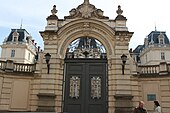Potocki Palace, Lviv
| Potocki Palace | |
|---|---|
палац Потоцьких | |
 | |
 | |
| General information | |
| Address | Mykoly Kopernyka Street, 15 |
| Town or city | Lviv |
| Country | Ukraine |
| Opened | 1880 |
| Website | |
| lvivgallery | |
The Potocki Palace in
At the start of the 20th century, the parkland gave way to a network of apartment buildings. It was confiscated by the Ukrainian Soviet Socialist Republic in 1940.[1] The palace itself was adapted for holding wedding ceremonies in 1972 and subsequently underwent restoration.
In the 2000s, the
The matches of the Women's World Chess Championship 2016 were played in the palace.[2]
Today, it hosts a branch of the
History of the Palace

The
The first palace was built in the style of classicism, designed by architect Ignatius Hambrez. It was a two-story rectangular building with a high roof. The facade was symmetrical with a central risalite, crowned with an attic and a balustrade. The first tier of the facade was rustic, the second tier of risalita was decorated with six pairs of ionic pilasters.[4] The owners were Maria Sanguszko and her husband Alfred Potocki. The palace was dismantled in 1860–1861. However, the construction of the new residence was delayed for three decades. Construction began only in 1880.
The design of the new palace was created in the style of
Potocki family - owners of the palace

In 1851, in the town of
After completing the diplomatic service, Alfred Potocki devoted his life to active political activity in Galicia. In 1863, he was elected
Palace
The building is made in the style of French classicism, brick, plastered, H-shaped in plan, with a developed central avant-corps and lateral wings. It is also three storeys high with an attic. The facades are decorated with figured window frames and rustication, moulded balconies and balustrades. The front entrance is decorated with an arched portico with stucco and ionic columns. Stucco decoration authored by Petr Garasimovich and probably Leonard Marconi.
On the ground floor there are front halls for the reception of guests. Some widely used features as part of decoration include stucco, gilding, coloured marble, valuable breeds of wood, painting. From the street on the courtyard, there are the grand monumental gate with two wings decorated with a cartoon. For receptions in the Pototsky palace there were places for crew entrance, meeting rooms. On the southwest side near the palace, stables with bas-reliefs of horses and services were built with unpublished red brick, allowing for access to the Ossolinski Street (now Stefanik, 7a). The Copernicus Palace separates the fence with the front door and guard gates. Tail gate opens onto the street. Silent. The total area of the palace is 3100 m².
By 1879 there was a large city park. Already at the end of the 19th – early-20th centuries around the Potocki Palace, a number of multistory buildings were built, some of which went out to the front facades to the street, and the rear parts to the palace. Therefore, the view of the Potocki palace remained open only from the Copernicus Street. At the end of the 1980s, in the palace park, a mine was laid for laying underground tram tunnels, and built an unsightly annex, which now houses the Museum of Ancient Ukrainian Book Art (Copernicus Street, 15a). At the initiative of BG Voznycky 2010, a park of castles and defensive structures of ancient Ukraine were laid in the park near the park, in which M 1:50 layouts of defensive structures were displayed.
Historical chronology
In January through March 1919 the palace was the residence of the mission of Bartholomew.
On 22 November 1919, American pilot Edmund Graves dropped into the palace during an air show over the centre of Lviv on the 1st anniversary of the city's liberation. The plane crash and the explosion of its fuel tanks caused a fire on the upper floors and the roof of the palace. Graves's parachute failed to open and he fell to his death on the pavements below. The repair and restoration of the building lasted until 1931.
From 1945 to 1972 the palace was used by the Institute of Geology and Geochemistry of Combustible Minerals of the
The palace was restored again between 1973 and 1974.
In 1996, the Lviv Palace of Arts was erected next to the building. In the 2000s, the Potocki Palace was handed over to the
A chapel in the Potocki Palace was opened in February 2015.
Photos
-
Lantern near the Entrance
-
Side View of the Palace
-
Facade of the palace
-
Palace interiors
-
Front entrance at the Palace Gates
-
Courtyard located at the back of the Palace
References
- ^ Matwijów M. (opr.), Sprawozdanie "Archiwa, biblioteki i muzea lwowskie" z 1940 r., Rocznik Lwowski, volume 5, 1997–1998, page 76. ISSN 1230-0829
- ^ "WWCCM Opening Ceremony will take place in Lviv Opera House". lviv2016.fide.com. Retrieved 27 February 2016.
- ^ "Палац Потоцьких | Львівська національна галерея мистецтв імені Бориса Возницького". lvivgallery.org.ua. Retrieved 2019-12-25.
- OCLC 62288048.
- )
- Памятники градостроительства и архитектуры Украинской ССР. Киев: Будивельник, 1983—1986. Том 3, с. 14.







